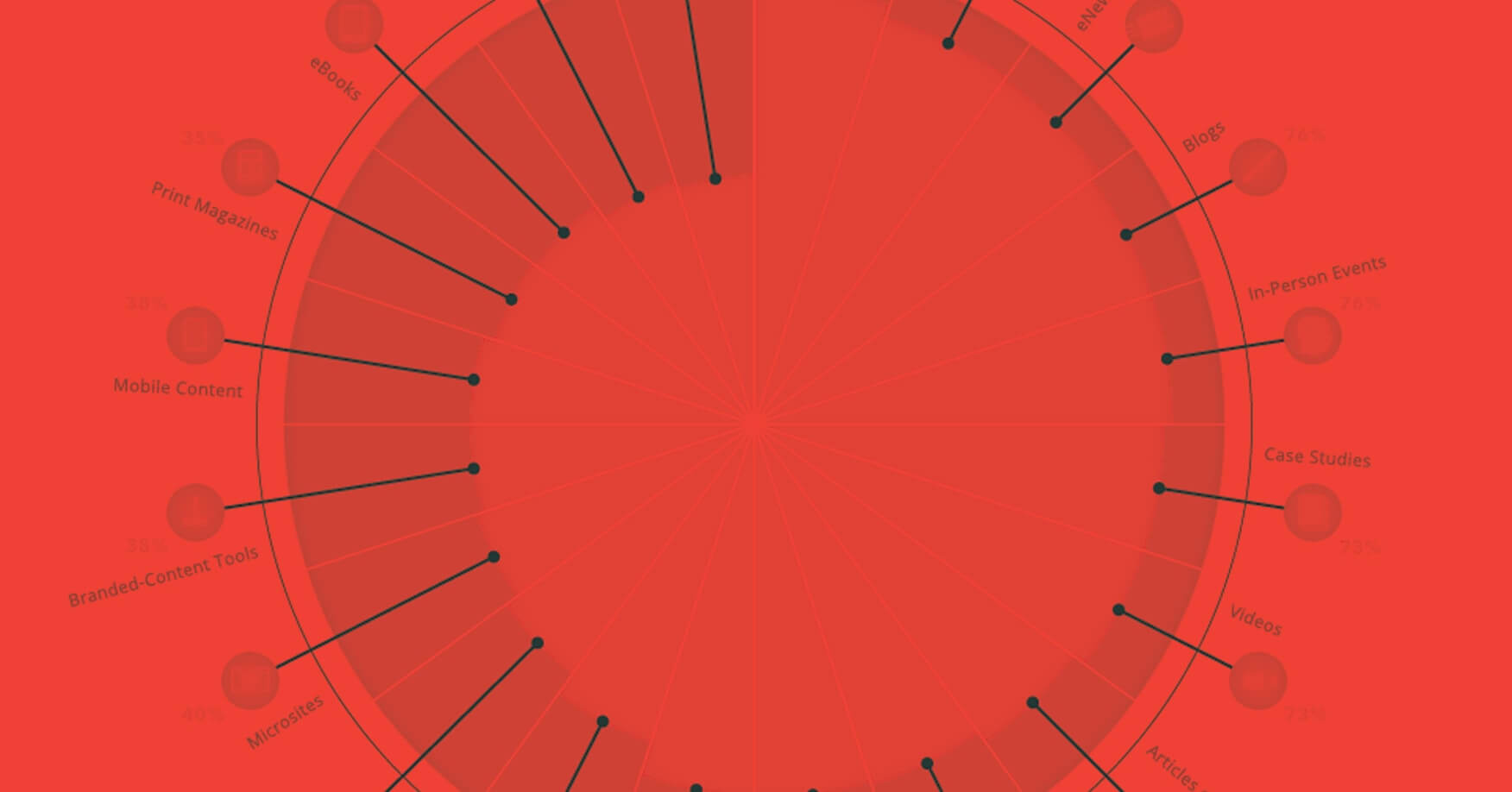If you’re a content marketer struggling to connect with an audience, pay attention to the words of Alex Rynne, Associate Content Marketing Manager at LinkedIn. As a content marketer and millennial, Rynne is in the trenches. She manages Global Content & Social Media Strategy at LinkedIn, runs strategy for the LinkedIn Marketing Solutions blog, and is always on the hunt for the best ideas to help marketers grow their businesses through content marketing.
We’re fans of LinkedIn’s content, some of which we’ve collaborated on, and we wanted to know a little more about how they run their machine. We caught up with Rynne to chat about everything from LinkedIn’s most effective content (spoiler: data + visuals) to trends for the future of content marketing. In this Q&A, she shares some great tactics to implement in your content strategy, tips on using LinkedIn to build your personal and professional brand, and the keys to working smarter, not harder in content marketing.

The Keys to the LinkedIn Content Strategy with Alex Rynned

C5: What specific things has LinkedIn done to produce more effective content?
AR: At LinkedIn, we believe in doing fewer things better, so we really try to zero in on the ideas that are going to make the most impact and move the needle. We sit down every quarter and come up with our 2-3 guiding principles or objectives. Sometimes there are rogue pieces of content that don’t fit into those pillars—we call those “intelligent risks.” If someone on the team feels strongly about a piece of content and has the data to believe it will perform well, go for it! Not every piece of content we publish is a home run, and that’s okay. What’s important is that we learn from it and iterate as we go.
We also have monthly content council meetings with everyone who is producing content all over the globe for LinkedIn Marketing Solutions. This helps us make sure we’re working toward the same goals, not duplicating efforts, and repurposing as much as we can.
C5: How do you come up with content ideas?
AR: There is never a lack of great content ideas coming from our team. We work with our regional and vertical teams, as well as our product marketing teams, to ensure a good mix of content that supports different objectives, whether it be thought leadership, lead generation, or brand awareness. We have great relationships with influencers, and we warmly welcome guest blogging opportunities. We also have what we call “spitball sessions” with our team, which is basically a no-judgement zone where we’re encouraged to throw out our wildest ideas. Some of our most successful content pieces have come from these fun and seemingly unproductive/silly sessions.
Finally, the LinkedIn Marketing Solutions team has mastered the art of repurposing. We take one large e-book and find opportunities to get as much fuel as we can out of it by pulling out blog posts, infographics, SlideShares, videos, webinars, and the list goes on. We also try to think about what our prospects and customers are Googling and try to provide the best answers for them to alleviate their pain points.
C5: What type of content resonates most with your audience?
AR: Highly visual, data-driven content performs really well for us. Everyone loves LinkedIn data, so any time we have the opportunity to partner with our insights team, we know we’ve got a home run on our hands.
Our audience not only loves product announcement and updates but also really basic how-to, tactical content surrounding LinkedIn Sponsored Content and Sponsored InMail. Brand examples and lists of top brands who are effectively using LinkedIn also perform well.
C5: What are the biggest mistakes brands make when trying to interact on LinkedIn?
AR: Not knowing your audience. If your content isn’t relevant, it doesn’t matter how much thought you put into your distribution strategy. In one of LinkedIn Global Content Marketing Leader Jason Miller’s recent presentations, he said, “[In a survey] 41% of overall respondents say they would consider ending a brand relationship because of irrelevant promotions, and an additional 22% say they would definitely defect from the brand.” Those are huge numbers. If you don’t know your audience, you can’t understand their pain points and how to alleviate them.
C5: How do you see LinkedIn changing the game when it comes to content marketing?
The LinkedIn Marketing Solutions team is pushing the boundaries of the kind of content people are used to seeing from LinkedIn. We’re moving past stock photography and experimenting with different creative styles, (e.g., our award-winning Attention is a Currency e-book).
We’re also blurring the lines of B2B and B2C content. Who says B2B has to be boring? There’s so much B2B could learn from B2C and vice versa. We’re looking forward to exploring this further.
C5: What role does visual content (infographics, GIFs, photos, etc.) play in your content mix?
AR: Visuals play a pivotal role in the success of our content. Lila King recently said, “We’re moving from a text-based communication style to one that is almost completely visual.” I couldn’t agree more. At LinkedIn Marketing Solutions we say that visual is the new headline. We have found that rich media, eye-catching imagery, and lifting short stats and quotes out of larger pieces of content performs really well.
You want your content to be the thumb stopper when people are scrolling through their feed. On my team, stock photography is a dirty word, so we try to get creative by taking photo-shoots with our team—real marketers at LinkedIn! It’s also worth mentioning that you don’t have to break the bank to create eye-catching imagery. There are free tools like Haiku Deck, Piktochart, Pixabay, and Pexels that can help.
We also believe that variety is the spice of life. We typically create 5-10 images for each campaign or e-book we launch so we don’t fatigue our audience, but also so we can A/B test the hell out of everything. For example, we test background color and using “e-book” vs. “guide” or an object vs. human.
A/B testing is like putting together a puzzle. We test and iterate until we optimize every component of your campaign. Oftentimes, some of the smallest tweaks in copy or an image have the greatest impact in performance.
C5: Does visual content perform better than written content alone?
AR: Absolutely. Time and time again we’ve seen content paired with rich media, video, or presented in a fun, themed way within a SlideShare or infographic perform better. Take our blogging food groups for example. This blogging food groups post continues to be a top performer for us.

Had we left out the infographic, the content wouldn’t have been as shareable and easily digestible.
C5: What are 3 tips you have for brands utilizing LinkedIn?
AR: According to Oktopost, 80% of B2B leads come from LinkedIn; and according to Hubspot, 43% of marketers say they have sourced a customer from LinkedIn, so it’s definitely a missed opportunity if you’re not sharing your content with the 414 million+ professionals waiting to consume your content.
I’d highly recommend checking out the LinkedIn Tactical Plan I wrote. After about 1 year in, I basically wrote down everything I do at LinkedIn day in and day out so other companies can adapt it to their strategy. To give you a preview, I talk about how we’ve invested in LinkedIn Company & Showcase Pages, LinkedIn SlideShare, publishing on LinkedIn, and LinkedIn Sponsored Content and Direct Sponsored Content to achieve our marketing objectives.
Over the past 2 years, 3 key themes have emerged in our content strategy on LinkedIn:
- Test everything: A/B test background color of images, verbiage we use, etc. We tested different times and frequencies of posting. We tried creating serial, themed posts. We even did some posts without links, just looking to start a conversation. We tried different headlines, post lengths, images, and content mixes.
- Visual is the new headline. When we added more visual interest, we got more attention. We strive to be the thumb stopper. We often achieve this by lifting stats and quotes our of larger pieces of content.
- Organic is good, but paid is better. It’s always great when your audience finds you, but with LinkedIn Sponsored Content, you can choose our audience. You can pick the people who will appreciate your content most and deliver it in a way that compels a click.
C5: What do you think is the most effective way to distribute content?
AR: Based on your goals and the metrics you use to grade success of your programs—and given how members engage on LinkedIn—you can take advantage of a mix of organic content and paid advertising opportunities. For us, a blend of organic + paid = success.
As you look to organically build your brand and content presence on LinkedIn, you can do that on your LinkedIn Company Page or specific Showcase Pages and through long-form posts or uploading content to LinkedIn SlideShare. These are free tools you can use to establish brand awareness and exhibit thought leadership to your prospects and customers.
And, as you start building your organic presence, in parallel, you can begin investing in a range of paid opportunities to reach the right people on LinkedIn and engage them at scale:
- In the LinkedIn Feed and beyond, using LinkedIn Sponsored Content
- In the LinkedIn Inbox with LinkedIn Sponsored InMail
- Early in the purchase process, using Display Ads
- Through other native ad formats, such as Dynamic Ads and Text Ads
C5: As a millennial company, we’re interested in how to market to (and as) millennials. How can LinkedIn help there?
Where to begin…
AR: The most successful millennials are social millennials, and this is because they are carefully building their personal brand. As Mel Carson said, “Your personal brand is your responsibility.” No manager is going to add it to your list of things to do, and there isn’t a handy-dandy manual for success. But it’s important. And it starts with finding your authentic voice on LinkedIn.
Here are 5 ways to showcase yourself on LinkedIn:
- Optimize your LinkedIn profile.
- Publish on LinkedIn.
- Create a LinkedIn SlideShare account.
- Make meaningful connections.
- Customize your feed by following those who matter most.

C5: What should brands consider when marketing to millennials?
AR: That’s an interesting conversation because I think the topic of marketing to millennials addressed by millennials themselves is underrepresented. The first step is understanding that, similar to other generations, millennials aren’t a group of clones with one set of beliefs, values, or habits. I think there are a couple of things that make us a bit different. We’re used to on-demand info. We’re skeptical, critical thinkers. We’re into transparency, and we want personalized experiences.
Study after study shows that millennials value experiences more than products. We want to connect, not just with a brand, but with the people behind the brand. We want our purchases to mean something beyond filling up a closet or a knick-knack shelf.
Keep in mind that 57% of millennials block ad content because it is too pushy. We’re doing a lot of self-education and prefer it that way. There’s no silver bullet answer here about how to reach them, but perhaps the best thing marketers can do is try to make a genuine connection and maybe that starts with publishing content that we truly care about.
C5: What trends do you anticipate for the future of content marketing?
AR: I think content marketing is the connective thread of all marketing. In fact, Seth Godin claims that “content marketing is the only marketing we have left.” And while research shows that 70% of B2B marketers will create more content than ever this year, 68% of marketers say consistently producing engaging content is a challenge. Although we’re creating a ton of content, I think we have to ask ourselves if we’re creating the right content. We’re all busy in marketing, but are we busy doing the right things?
I think the future of marketing holds two things:
- Fewer things done better.
- Personalization at scale.
Shafqat Islam, CEO of NewsCred, said companies who focus on connecting with their consumers have a growth rate triple that of their competitors. We need to focus on creating genuinely helpful content for our target audiences and the rest of the things we’re looking for— engagement, leads, thought leadership, etc.—will follow.
For more tips on content marketing, follow Rynne on Twitter. You can also check out these fixes for your biggest content marketing problems, our favorite resources for creating more effective content, and the ways your company culture can help your content marketing.





